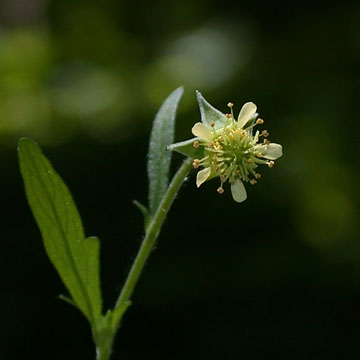

Geum virginianum - (image 1 of 6)
Taxonomy
Family: Rosaceae
Habitat
Moist to dry upland woods, often associated with oak-hickory.
Associates
Distribution
MA and NY to IN, south to NC and TN.
Morphology
Herbaceous perennial; stems 25-100 cm, puberulent and often densely hirsute towards the base; leaves often deeply incised with blunt to obtusely pointed marginal teeth; petals custard yellow, typically narrow oblong, 2-3.5 mm long, shorter than the sepals; fruiting receptacle densely hirsute.
Notes
Flowers late June to July
Wetland indicator: FACU
This species is rare in NY with many erroneous historic records attributed to misapplication of the name G. virginianum to G. lacinatum or to misidentification of G. canadense.
Raynor (1945) proposed that G. virginianum is a hybrid of G. aleppicum and G. canadense, however the voucher specimen for the purported F1 hybrid (collected in Tioga County NY) has much sharper leaf teeth, the stem is only sparsely hirsute, and the pictures of the flowers on the plates show that they are at least as long as the sepals and much wider than is typical in G. virginianum. The purported F2 hybrid grown from seeds from these plants also had petals (reportedly white) about as long as the sepals (though they were overall smaller), leaf teeth slightly less pointed but still not as rounded as in G. virginianum, and basal leaves with large terminal lobes suggesting possible backcrossing with G. aleppicum (the foliage of the specimen also darkened upon drying as is typical with G. aleppicum). I suspect that Raynor's conclusion was based on comparison to material that was not true G. virginianum.
References
Gleason, Henry A. and A. Cronquist. 1991. Manual of Vascular Plants of
Northeastern United States and Adjacent Canada. Second Ed.
The New York Botanical Garden. Bronx, NY
Raynor, L.A. 1945. A Cytotaxonomic Investigation of Geum. Cornell University. 368 pp.
|
Michael Hough © 2018 |